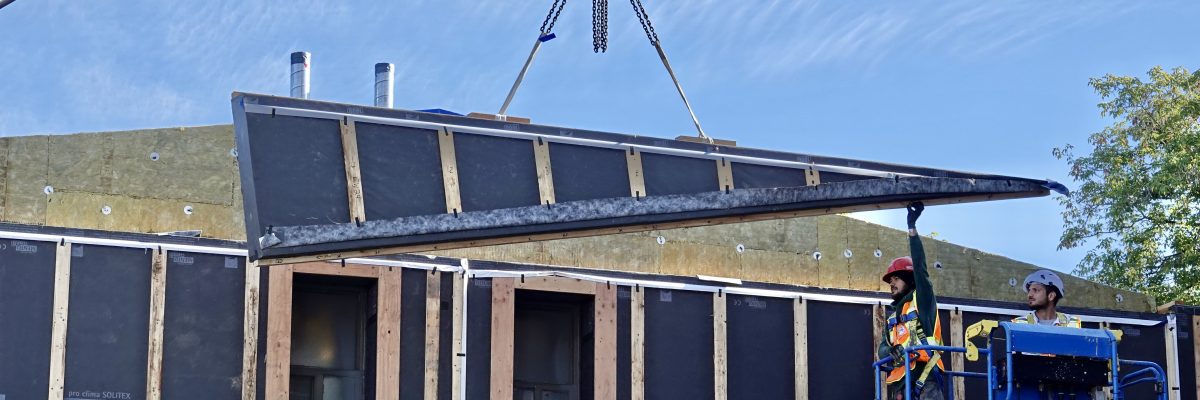Photo: Installing prefabricated overcladding panels in Scarborough as part of a deep retrofit project with Toronto Community Housing. Panels by Simple Life Homes. Image by Nhan Ng Productions
How can we make building retrofits faster, easier, and less expensive? There are lessons to learn from Europe about the power of industrialization when applied to the process. From our own experience with TAF’s Retrofit Accelerator, we see prefabricated overcladding panels as an important decarbonization and adaptation tool and a way to modernize our approach to holistic deep retrofits.
Prefabricated overcladding refers to airtight, super-insulated panels that are usually built off-site and attached to the outside of existing buildings to provide facade renewal and energy efficiency.
Overcladding won’t be necessary or viable for all building retrofits, but in older buildings with little or no insulation and tired cladding, prefabrication offers the promise of better performance, reduced timelines, and lower costs. TAF is seeing demand for suppliers of prefabricated panels first-hand—we’re currently supporting six retrofit projects (representing over 500 homes) that are using or evaluating prefabricated panels. These projects include:
- A 16-unit low-rise EnerPHit retrofit (in construction)
- A 22-storey tower targeting near EnerPHit performance (schematic design)
- Four different townhouse / low-rise complexes (concept design)
We’re seeing increasing demand, but the market for prefabricated panels is still developing and somewhat opaque. That’s why TAF decided to go on the search for panel suppliers in the region. By prequalifying suppliers, we help building owners by identifying and sharing the suppliers that pass our technical evaluation; building owners can see and contact the organizations that provide high-performance panels today. We also signal demand to those companies that might be considering developing panels for retrofit applications now or in the future.
We commissioned WSP for their market research and building science expertise, and convened a fantastic team that included members of TAF, Toronto Community Housing and Durham Regional Local Housing Corporation to develop procurement and technical evaluation materials.
Here’s what we learned:
- Demand for suppliers of prefabricated overcladding panels for retrofits exists today and is growing. We know this from the projects we’re working on and the discussions we’re having with building owners.
- Not all panels are suitable for all buildings. We opted to develop two rosters of panel suppliers, one for pre-engineered panels and another for pre-assembled panels. Pre-engineered panels are typically constructed in a manufacturing facility and would apply to larger part 3 buildings. Pre-assembled panels might be constructed in a temporary facility or even a dedicated location on a retrofit site. These typically would apply to low-rise (part 9) buildings.
- The installer and manufacturer relationships are critical. Ideally, it’s a single entity responsible for fabrication and installation, but if not, it’s important that installers are approved by the panel fabricator. Panel suppliers must be able to stand behind the installed panels.
- The supply of prefabricated panels in the GTHA market is limited. This is not unexpected, and something we’re trying to address with this initiative! We prequalified three panels through this initial process, but we’ve had conversations with many current and future retrofit panel suppliers. There’s little doubt that our rosters will grow significantly over the next 3-5 years.
The first cohort of panels that have met our technical requirements:
Pre-Engineered Panelized Systems
Pre-Assembled Panelized Systems
- Non-Combustible Panel by Quantum Passivhaus
- Wood-Framed Panel by Quantum Passivhaus
We learned a great deal through this market-development initiative and hope that others can benefit. Get in touch if you have questions or feedback.
Get the full WSP report: Prefabricated Overcladding Solutions for Deep Retrofits


The post was very good, I appreciate how you explain it, Keep the posts coming!